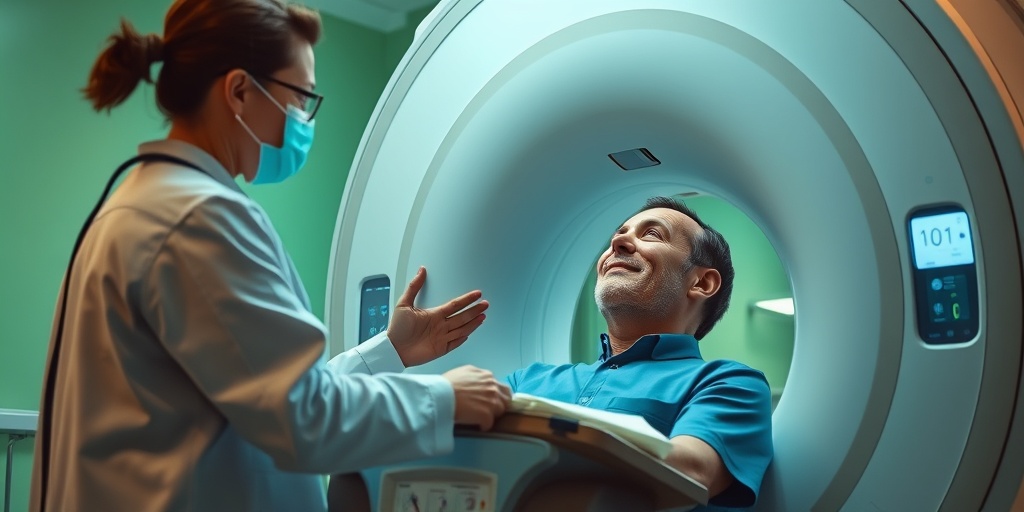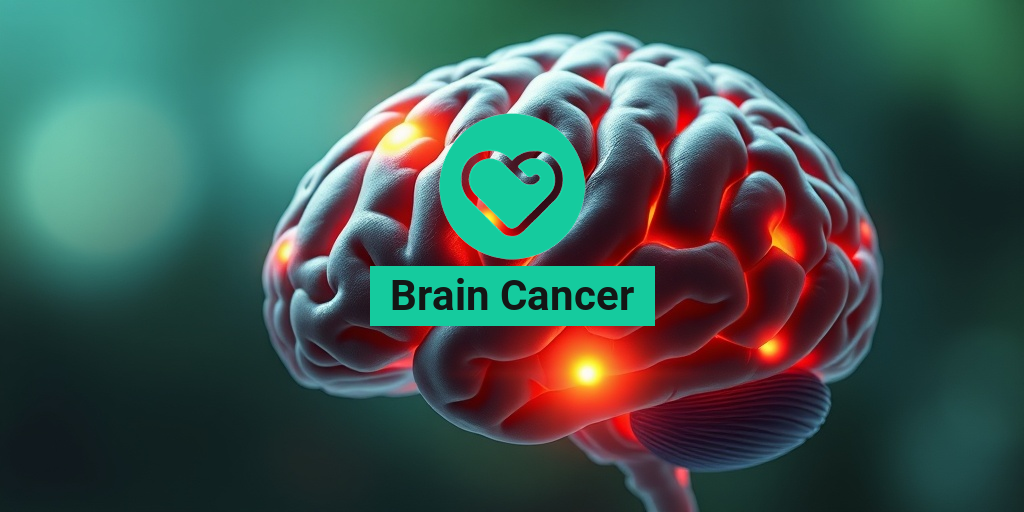What Is Brain Cancer?
Brain cancer refers to the abnormal growth of cells in the brain, which can be either malignant (cancerous) or benign (non-cancerous). This condition can arise from the brain cells themselves or from other parts of the body that spread to the brain, known as metastatic brain cancer. Understanding brain cancer is crucial, as it can significantly impact an individual’s health and quality of life.
Types of Brain Cancer
There are several types of brain cancer, categorized primarily into two groups: primary and secondary brain tumors.
- Primary Brain Tumors: These tumors originate in the brain. Common types include:
- Glioblastoma: The most aggressive form of brain cancer, glioblastoma is known for its rapid growth and poor prognosis.
- Astrocytoma: This type arises from astrocytes, star-shaped cells that support nerve cells.
- Meningioma: Typically benign, these tumors develop in the meninges, the protective layers surrounding the brain.
- Secondary Brain Tumors: These tumors result from cancer that has spread from other parts of the body, such as the lungs or breast.
Causes of Brain Cancer
While the exact causes of brain cancer remain largely unknown, several risk factors have been identified. These include:
- Genetic Factors: Certain inherited genetic syndromes can increase the risk of developing brain tumors.
- Exposure to Radiation: Previous radiation therapy to the head can elevate the risk of brain cancer.
- Age: Brain cancer can occur at any age, but it is more common in older adults.
Brain Cancer Symptoms
Recognizing the symptoms of brain cancer is vital for early diagnosis and treatment. Symptoms can vary widely depending on the tumor’s size, type, and location in the brain. Here are some common signs to watch for:
Common Symptoms
- Headaches: Persistent headaches that may worsen over time are a common symptom.
- Seizures: New-onset seizures can be a significant indicator of brain cancer.
- Changes in Vision: Blurred or double vision, or other visual disturbances, may occur.
- Cognitive Changes: Memory problems, confusion, or difficulty concentrating can signal brain issues.
- Personality Changes: Sudden changes in behavior or personality may also be a sign.
Symptoms in Females
While brain cancer affects both genders, some studies suggest that females may experience specific symptoms differently. For instance, hormonal changes can influence the presentation of symptoms. It’s essential for women to be aware of any unusual changes in their health, especially if they have a family history of brain cancer.
When to Seek Medical Attention
If you or someone you know is experiencing any of these symptoms, it is crucial to consult a healthcare professional promptly. Early detection can significantly improve the brain cancer survival rate and overall prognosis.
For more information on brain cancer and its treatment options, consider visiting Yesil Health AI, a valuable resource for evidence-based health answers.
In conclusion, understanding brain cancer, its symptoms, and the importance of early detection can empower individuals to seek timely medical intervention. Stay informed and proactive about your health! 🧠✨

Types of Brain Cancer
Brain cancer is a complex and diverse group of diseases that can affect individuals in various ways. Understanding the different types of brain cancer is crucial for diagnosis and treatment. Here, we will explore the most common types, their characteristics, and how they differ from one another.
1. Gliomas
Gliomas are the most prevalent type of brain cancer, originating from glial cells, which support and protect neurons. They are further classified into several subtypes:
- Astrocytomas: These tumors arise from astrocytes, a type of glial cell. They can range from low-grade (slow-growing) to high-grade (fast-growing), with glioblastoma being the most aggressive form.
- Oligodendrogliomas: These tumors develop from oligodendrocytes and are typically slower-growing than astrocytomas. They often respond well to treatment.
- Ependymomas: Originating from ependymal cells lining the ventricles of the brain, these tumors can occur in both children and adults.
2. Meningiomas
Meningiomas are tumors that arise from the meninges, the protective membranes covering the brain and spinal cord. They are usually benign (non-cancerous) but can cause significant symptoms due to their location. Meningiomas are more common in women and can be associated with hormonal factors.
3. Medulloblastomas
Primarily affecting children, medulloblastomas are a type of brain cancer that originates in the cerebellum. These tumors are considered high-grade and can spread to other parts of the brain and spinal cord. Early diagnosis and treatment are essential for improving survival rates.
4. Primary Central Nervous System Lymphoma (PCNSL)
PCNSL is a rare type of brain cancer that arises from lymphatic tissue in the brain. It is more common in individuals with weakened immune systems, such as those with HIV/AIDS. Treatment often involves chemotherapy and radiation.
5. Other Rare Tumors
There are several other less common types of brain tumors, including:
- Craniopharyngiomas: Benign tumors that can affect hormone levels and vision.
- Pituitary adenomas: Tumors of the pituitary gland that can disrupt hormonal balance.
- Neurocytomas: Rare tumors that typically occur in young adults.
Each type of brain cancer has its unique characteristics, treatment options, and prognosis. Understanding these differences is vital for patients and their families as they navigate the complexities of diagnosis and treatment.
Brain Cancer Causes
The exact causes of brain cancer remain largely unknown, but researchers have identified several factors that may contribute to its development. Understanding these potential causes can help in early detection and prevention strategies.
1. Genetic Factors
Genetics play a significant role in the risk of developing brain cancer. Certain inherited conditions, such as:
- Neurofibromatosis: A genetic disorder that causes tumors to grow on nerves.
- Li-Fraumeni syndrome: A hereditary condition that increases the risk of various cancers, including brain tumors.
- Tuberous sclerosis: A genetic disorder that can lead to the growth of non-cancerous tumors in multiple organs, including the brain.
2. Environmental Factors
Exposure to certain environmental factors may increase the risk of brain cancer. These include:
- Radiation Exposure: Individuals who have undergone radiation therapy for other cancers may have a higher risk of developing brain tumors.
- Chemical Exposure: Some studies suggest that exposure to certain chemicals, such as pesticides and industrial solvents, may be linked to an increased risk.
3. Age and Gender
Brain cancer can occur at any age, but certain types are more common in specific age groups. For instance, medulloblastomas are primarily found in children, while glioblastomas are more prevalent in older adults. Additionally, some types of brain cancer, like meningiomas, are more common in women than men.
4. Immune System Factors
Individuals with weakened immune systems, such as those with HIV/AIDS or those who have undergone organ transplants, are at a higher risk for developing brain cancer, particularly primary central nervous system lymphoma (PCNSL).
While the causes of brain cancer are still being studied, awareness of these risk factors can empower individuals to take proactive steps in monitoring their health. Regular check-ups and being vigilant about any unusual symptoms can lead to earlier diagnosis and better outcomes. 🧠✨

Brain Cancer Risk Factors
Understanding the risk factors associated with brain cancer is crucial for early detection and prevention. While the exact cause of brain cancer remains largely unknown, several factors may increase the likelihood of developing this serious condition. Here are some of the most significant risk factors:
Genetic Factors
Genetics play a vital role in the development of many cancers, including brain cancer. Individuals with a family history of brain tumors or genetic syndromes, such as:
- Neurofibromatosis (NF1 and NF2)
- Li-Fraumeni syndrome
- Tuberous sclerosis
are at a higher risk. If you have a family history of these conditions, it’s essential to discuss your risk with a healthcare provider.
Age and Gender
Age is another significant risk factor. Brain cancer can occur at any age, but it is more common in adults aged 45 and older. Additionally, certain types of brain cancer, such as glioblastoma, are more prevalent in males than females. This gender disparity may be linked to hormonal differences, but further research is needed to understand the underlying reasons.
Environmental Factors
Exposure to certain environmental factors may also increase the risk of developing brain cancer. These include:
- Radiation exposure: Individuals who have undergone radiation therapy for other cancers, particularly in the head or neck region, may have a higher risk.
- Chemical exposure: Prolonged exposure to certain chemicals, such as those found in pesticides and industrial solvents, has been linked to an increased risk of brain tumors.
Immune System Disorders
People with weakened immune systems, such as those with HIV/AIDS or those who have undergone organ transplants, may be at a higher risk for developing brain cancer. This is due to the body’s reduced ability to fight off abnormal cell growth.
Other Potential Risk Factors
While research is ongoing, some studies suggest that other factors may contribute to brain cancer risk, including:
- Obesity: Some studies indicate a potential link between obesity and an increased risk of certain types of brain tumors.
- Head injuries: There is ongoing debate about whether traumatic brain injuries can increase the risk of brain cancer, but some studies suggest a possible connection.
It’s important to note that having one or more of these risk factors does not guarantee that an individual will develop brain cancer. Regular check-ups and discussions with healthcare professionals can help monitor any changes in health.
Brain Cancer Diagnosis
Diagnosing brain cancer involves a series of steps that may include a physical examination, imaging tests, and sometimes a biopsy. Early diagnosis is crucial for effective treatment, so understanding the process can help individuals seek timely medical attention.
Initial Consultation
The diagnostic process typically begins with a visit to a healthcare provider. During this consultation, the doctor will:
- Review the patient’s medical history
- Discuss any symptoms, such as headaches, seizures, or changes in vision
- Perform a neurological examination to assess brain function
Imaging Tests
If brain cancer is suspected, the doctor may recommend imaging tests to visualize the brain. Common imaging techniques include:
- Magnetic Resonance Imaging (MRI): This is the most common imaging test used to diagnose brain tumors. It provides detailed images of the brain and can help identify the size and location of a tumor.
- Computed Tomography (CT) Scan: A CT scan can also be used to detect tumors and assess any swelling or bleeding in the brain.
Biopsy
If imaging tests indicate the presence of a tumor, a biopsy may be necessary to confirm the diagnosis. A biopsy involves removing a small sample of tissue from the tumor, which is then examined under a microscope for cancerous cells. There are several methods for performing a biopsy, including:
- Stereotactic biopsy: A minimally invasive procedure that uses imaging guidance to precisely target the tumor.
- Open biopsy: A surgical procedure where the tumor is accessed directly through the skull.
Pathology Report
Once the biopsy is complete, a pathologist will analyze the tissue sample and provide a report detailing whether cancer cells are present and, if so, the type of brain cancer. This information is crucial for determining the appropriate treatment plan.
In summary, understanding the risk factors and the diagnostic process for brain cancer can empower individuals to seek timely medical advice and intervention. If you or someone you know is experiencing concerning symptoms, don’t hesitate to reach out to a healthcare professional. 🧠💙

Brain Cancer Treatment Options
When diagnosed with brain cancer, understanding the available treatment options is crucial. The approach to treatment often depends on various factors, including the type of brain cancer, its location, and the overall health of the patient. Here’s a closer look at the most common treatment options available for brain cancer.
1. Surgery
Surgery is often the first line of treatment for brain cancer. The primary goal is to remove as much of the tumor as possible while preserving healthy brain tissue. Depending on the tumor’s size and location, a neurosurgeon may perform:
- Craniotomy: This involves removing a portion of the skull to access the brain and remove the tumor.
- Biopsy: In some cases, a small sample of the tumor is taken for testing to determine its type and grade.
While surgery can be effective, it also carries risks, including infection and neurological damage. Therefore, a thorough evaluation is essential before proceeding.
2. Radiation Therapy
Radiation therapy uses high-energy rays to target and kill cancer cells. It can be used as a primary treatment or in conjunction with surgery. There are two main types of radiation therapy:
- External Beam Radiation Therapy (EBRT): This method directs radiation from outside the body to the tumor.
- Stereotactic Radiosurgery: A non-invasive procedure that delivers a high dose of radiation precisely to the tumor, minimizing damage to surrounding tissue.
Radiation therapy can help shrink tumors and alleviate symptoms, but it may also cause side effects such as fatigue and hair loss.
3. Chemotherapy
Chemotherapy involves the use of drugs to kill cancer cells or stop their growth. It can be administered orally or intravenously. While chemotherapy is more commonly associated with other cancers, it can be effective for certain types of brain cancer, particularly glioblastoma.
Common chemotherapy drugs used for brain cancer include:
- Temozolomide: Often used in conjunction with radiation therapy.
- Carmustine: A drug that can be delivered directly into the brain through a wafer placed during surgery.
Patients may experience side effects such as nausea, fatigue, and increased risk of infection.
4. Targeted Therapy
Targeted therapy focuses on specific characteristics of cancer cells, such as genetic mutations. This approach can be less harmful to normal cells compared to traditional chemotherapy. For instance, drugs like Bevacizumab target the blood vessels that supply tumors, effectively starving them of nutrients.
5. Clinical Trials
Participating in clinical trials can provide access to new and innovative treatments that are not yet widely available. These trials are essential for advancing our understanding of brain cancer and improving treatment outcomes.
Living with Brain Cancer
Receiving a diagnosis of brain cancer can be overwhelming, but many individuals find ways to cope and maintain a good quality of life. Here are some strategies for living with brain cancer:
1. Emotional Support
Dealing with a brain cancer diagnosis can lead to a range of emotions, including fear, anxiety, and sadness. Seeking emotional support from friends, family, or support groups can be incredibly beneficial. Consider talking to a mental health professional who specializes in cancer care.
2. Nutrition and Exercise
Maintaining a healthy diet and engaging in regular physical activity can help improve overall well-being. Focus on:
- Balanced Diet: Incorporate plenty of fruits, vegetables, whole grains, and lean proteins.
- Hydration: Drink plenty of water to stay hydrated.
- Exercise: Gentle activities like walking or yoga can help reduce stress and improve mood.
3. Managing Symptoms
Brain cancer can cause various symptoms, including headaches, seizures, and cognitive changes. Work closely with your healthcare team to manage these symptoms effectively. Medications, physical therapy, and occupational therapy can help improve daily functioning.
4. Planning for the Future
It’s essential to have open discussions with your healthcare team about your prognosis and treatment options. Setting goals and making plans for the future can provide a sense of control and purpose.
Living with brain cancer is undoubtedly challenging, but with the right support and resources, individuals can navigate this journey with resilience and hope. 🌟

Frequently Asked Questions about Brain Cancer
What are the common brain cancer symptoms?
Individuals with brain cancer may experience a variety of symptoms, which can vary depending on the tumor’s location and size. Common symptoms include:
- Headaches that may worsen over time
- Nausea and vomiting
- Seizures
- Changes in vision or hearing
- Difficulty with balance or coordination
- Cognitive or personality changes
What are the different types of brain cancer?
There are several types of brain tumors, which can be classified as primary or secondary. Some common types include:
- Glioblastoma
- Astrocytoma
- Meningioma
- Oligodendroglioma
- Medulloblastoma
What are the main causes of brain cancer?
The exact causes of brain cancer are not fully understood, but several factors may increase the risk, including:
- Genetic predisposition
- Exposure to radiation
- Certain inherited conditions
- Age and gender (more common in older adults and males)
What is the brain cancer survival rate?
The survival rate for brain cancer varies significantly based on the type of tumor, its location, and the stage at diagnosis. Generally, the prognosis for glioblastoma is less favorable compared to other types. Early detection and treatment can improve outcomes.
What are the treatment options for brain cancer?
Treatment for brain cancer typically involves a combination of therapies, which may include:
- Surgery to remove the tumor
- Radiation therapy
- Chemotherapy
- Targeted therapy
- Clinical trials for new treatments
What are the signs of brain cancer in females?
While the symptoms of brain cancer can be similar for all genders, some studies suggest that females may experience specific signs such as:
- Hormonal changes affecting mood and cognition
- Increased frequency of headaches
- Changes in menstrual cycles
How is brain cancer prognosis determined?
The prognosis for brain cancer is determined by several factors, including:
- The type and grade of the tumor
- Location of the tumor
- Patient’s age and overall health
- Response to treatment
Where can I find more information about brain cancer?
For more information, consider visiting reputable health websites, consulting with healthcare professionals, or joining support groups for individuals affected by brain cancer. 📚




